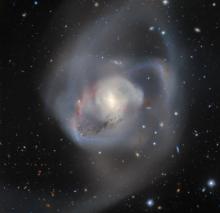Listen to today's episode of StarDate on the web the same day it airs in high-quality streaming audio without any extra ads or announcements. Choose a $8 one-month pass, or listen every day for a year for just $30.
You are here
Super Clusters
In many ways, the galaxy NGC 253 is a lot like our own. Like the Milky Way, it’s a barred spiral. That means its stars form a large disk. It’s accented by bright spiral arms and a long bar of stars in the middle. The galaxy also is about the same mass as ours. And the black hole in its core is comparable to the one at the heart of the Milky Way.
In one way, though, the galaxies are quite different: NGC 253 is giving birth to many more stars.
Most of that activity is taking place in a few dozen clusters in the galaxy’s core. Each of them contains tens of thousands of stars, most of which are quite young. And a few of them are super-clusters, with millions of stars.
The biggest is concealed behind clouds of dust. A study a few years ago said it’s about 14 million times the mass of the Sun. But it’s only a few million years old. So it’s given birth to a lot of stars in a short time — and is still cranking them out today.
The clusters contain many bright, massive stars, which produce powerful “winds” of charged particles. The winds appear to be blowing away gas and dust in other parts of the galaxy. So the regions that are churning out millions of new stars may prevent the birth of stars elsewhere in this busy galaxy.
NGC 253 is about 12 million light-years away, in Sculptor. The constellation is low in the south at nightfall. Under dark skies, the galaxy is visible through binoculars as a hazy swash of light.
Script by Damond Benningfield






